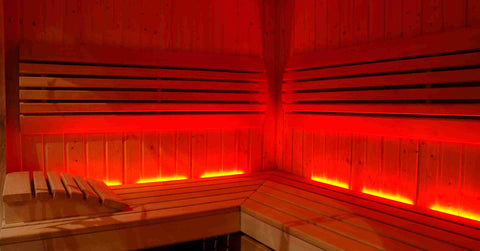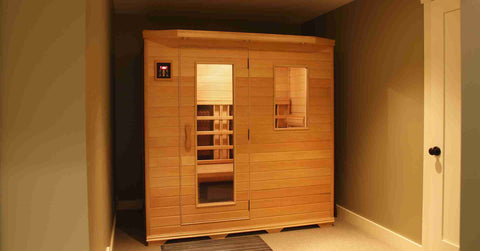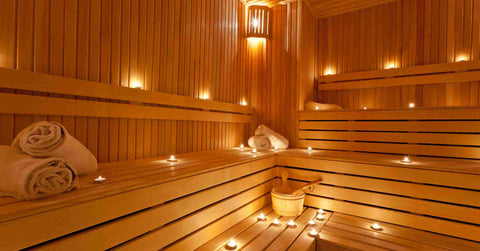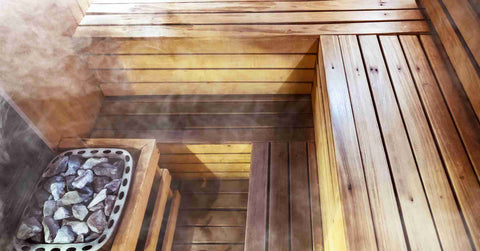Sauna for Depression Relief: How Heat Therapy Can Improve Your Mood
Saunas have long been revered for their potential health benefits, both physical and mental. Recent research has shed particular light on the intriguing connection between sauna use and depression relief. The complex physiological and psychological mechanisms through which frequent sauna therapy alleviates depressive symptoms form the basis for its growing popularity as a supplemental treatment for mood disorders.
In this blog post, we examine the science behind how elevated body temperatures modulate critical neurotransmitters and neurotrophic factors implicated in depression. It explores the cascade of cardiovascular, muscular, and immunological effects induced by sauna sessions that lead to overall relaxation and restore homeostatic balance. The psychological benefits of mindfulness, social interaction, and stress reduction conferred by regular sauna bathing are described in detail, as well.

The Science Behind Sauna Use
The potential therapeutic effects of sauna use are deeply rooted in the physiological responses it triggers in the human body, making it a potent tool for physical relaxation and mental health improvement.
When you enter a sauna, your body is subjected to high temperatures, usually within the range of 70°C to 100°C (158°F to 212°F), depending on the type of sauna—be it a traditional Finnish sauna, an infrared sauna, or a steam room. This intense heat environment can initiate a series of physiological changes that mimic the body's response to mild fever, a natural mechanism for fighting infections and promoting healing.
Heat Stress and Hyperthermic Conditioning
One of the primary responses to sauna bathing is "heat stress." This condition challenges the body to maintain its core temperature within safe limits, activating a range of adaptive responses.
Heat stress stimulates the cardiovascular system, increasing heart rate much like moderate exercise. This cardiovascular workout helps improve heart health and blood circulation, enhancing the delivery of nutrients and oxygen throughout the body.
Hyperthermic conditioning, or the acclimation to heat stress over repeated sauna sessions, can increase the body's ability to tolerate heat. This adaptation leads to various beneficial outcomes, such as increased plasma volume and greater efficiency in blood flow to the heart and muscles, reducing the strain on the cardiovascular system during physical exertion.
Endorphin Release and Relaxation
Sauna use has shown the potential to promote the release of endorphins, the body's natural painkillers, which are known for their mood-lifting and analgesic properties. The heat-induced endorphin rush contributes to a feeling of well-being and relaxation, helping to alleviate stress and anxiety, common contributors to depression.
Detoxification Through Sweating
While the concept of detoxification through sweating is often debated, sauna bathing undoubtedly leads to significant sweating, which can help the body rid itself of toxins via the skin.
Though the kidneys and liver are the primary organs for detoxification, sweating can complement this process by eliminating substances like heavy metals and other pollutants through the skin, potentially reducing the body's toxic load.
Improvement in Sleep Patterns
Regular sauna use, especially in the evening, may aid in promoting better sleep patterns. The post-sauna cooling period mimics the natural drop in body temperature that occurs before sleep, signaling the body that it's time to rest. This can lead to deeper, more restorative sleep, which is imperative for mental well-being and recovery.
Neurological Effects
Emerging research suggests that sauna use may have direct neurological benefits, potentially influencing brain health.
The heat stress from sauna use has been shown to increase the production of brain-derived neurotrophic factor (BDNF), a protein that plays a key role in neurogenesis, and the creation of new neurons. This effect can enhance cognitive function and resilience against neurological diseases.
By delving into the science behind sauna use, it becomes clear why this ancient practice has stood the test of time and is now being embraced as a tool to maintain mental health and wellness. The combination of cardiovascular exercise, relaxation, detoxification, and neurological benefits provides a solid foundation for the therapeutic effects of saunas on depression and overall well-being.

Sauna as a Form of Thermotherapy
Thermotherapy, the therapeutic use of heat, has been a cornerstone of holistic healing practices for centuries, with typical sauna bathing habits being one of its most recognized and valued forms.
Saunas, by their very design, create an environment where the body is exposed to elevated temperatures, leading to a cascade of physiological effects that constitute the essence of thermotherapy.
This section delves into the specifics of how saunas function as a potent form of thermotherapy and the underlying mechanisms that contribute to their therapeutic effects.
Mechanisms of Heat Transfer in Saunas
Saunas utilize different methods of heat transfer to elevate the body's temperature, primarily through convection and radiation:
Traditional Finnish Saunas
These saunas heat the air around the user through a stove, either wood-burning or electric, that warms rocks. When water is thrown onto these heated rocks, it creates a burst of steam, increasing the humidity briefly and enhancing the sensation of heat through convection.
Infrared Sauna
Differing from traditional saunas, infrared saunas do not heat the air significantly but instead use infrared panels to emit infrared light, which is absorbed directly by the skin's surface, heating the body primarily through radiation. This direct form of heat transfer in infrared sauna therapy allows for lower ambient temperatures while still effectively raising the body's core temperature.
Steam Rooms
While not saunas in the traditional sense, steam rooms, and steam showers also fall under the category of thermotherapy. They use a generator to produce a high-humidity environment by releasing steam into an enclosed space, heating the body through the warm, moist air.
Related: Can Infrared Saunas Cause Cancer? Here's What Science Says
Physiological Responses to Sauna Heat
The body's response to the heat in a sauna treatment is multifaceted, involving several systems and processes:
- Thermoregulation: In an attempt to maintain homeostasis, the body responds to elevated temperatures by increasing sweat production and dilating blood vessels near the skin's surface. This process, known as vasodilation, enhances heat dissipation through the skin and is an important aspect of the body's cooling mechanism.
- Cardiovascular Adjustments: The heart rate increases in a sauna, similar to the effects of moderate exercise, to facilitate the increased blood flow to the skin required for heat dissipation. This cardiovascular workout can improve cardiac function and efficiency over time.
- Muscle and Joint Relief: The heat in a sauna helps to relax muscles and alleviate stiffness, reducing pain associated with conditions like arthritis or muscle soreness after exercise. The increased blood flow to muscles speeds up recovery by bringing more oxygen and nutrients to the affected areas and removing metabolic waste products more efficiently.
Therapeutic Benefits of Sauna-Induced Hyperthermia
The state of hyperthermia induced during a sauna session has several therapeutic benefits:
- Detoxification: While the primary organs of detoxification are the liver and kidneys, sweating in a sauna can aid in the elimination of toxins through the skin, complementing the body's natural detoxification processes.
- Immune System Boost: Exposure to the heat of a sauna can stimulate the production of white blood cells, enhancing the body's immune response. The 'artificial fever' induced by the sauna may also play a role in stimulating the immune system, much like the body's natural response to infection. The sauna may be able to relieve some of your symptoms if you're sick.
- Stress Reduction and Mental Relaxation: The heat stress from sauna use triggers the release of endorphins, the body's natural stress-relievers, promoting relaxation and a sense of well-being. This can be particularly beneficial for individuals suffering from stress-related conditions, including depression and anxiety.
The sauna as a form of thermotherapy harnesses the natural response of the body to heat, promoting healing, relaxation, and an enhanced sense of well-being. A sauna can potentially be an effective tool for treating anxiety and depression because it activates physiological processes.

Sauna for Depression: The Connection
The intriguing relationship between typical sauna bathing habits and depression relief is rooted in the complex interplay of physiological, psychological, and neurological responses to heat stress.
Researchers treated major depressive disorder patients with heat so that their core body temperatures were equivalent to sauna temperatures. Following just one treatment session, subjects experienced mood elevations that lasted for several weeks.
A new study from the University of California - San Francisco suggests a link between higher body temperature and depression. The researchers found that people with depression tend to have elevated core body temperatures compared to those without the condition. This finding indicates that therapies aimed at lowering body temperature, such as heat therapy through hot tubs or saunas, could potentially provide mental health benefits for those with depression. More research is still needed, but manipulating body temperature may offer a novel avenue for treating this common mood disorder that affects millions.
In addition to alleviating symptoms of depression, sauna use has been noted for its potential benefits in managing conditions often associated with mental health challenges, such as chronic fatigue syndrome.
One study shows that thermal therapy and sauna bathing can effectively reduce symptoms of chronic fatigue and improve overall well-being.
This section explores the multifaceted mechanisms through which repeated sauna therapy can positively help alleviate mental illness, particularly focusing on its role in alleviating symptoms of depression.
Neurochemical Responses to Heat Stress
One of the primary ways in which sauna use can mitigate depression is through the modulation of neurochemicals associated with mood regulation:
- Endorphin Release: The heat stress induced by sauna use prompts the body to release endorphins, also known as "feel-good" hormones. These natural chemicals act as analgesics and sedatives, providing a sense of relief from pain and stress, and contributing to an uplifted mood and a state of relaxation.
- Reduction of Cortisol Levels: Sauna sessions can lead to a decrease in cortisol, the body's primary stress hormone. Elevated cortisol levels are often associated with chronic stress and depression. By reducing cortisol, sauna use can help alleviate stress and promote a more balanced emotional state.
Impact on Brain-Derived Neurotrophic Factor (BDNF)
Exposure to heat, particularly the type of whole-body hyperthermia achieved in a sauna, has been shown to increase the levels of Brain-Derived Neurotrophic Factor (BDNF).
BDNF plays a critical role in neuroplasticity, the brain's ability to form new neural connections, which is essential for learning, memory, and mood regulation. Higher levels of BDNF are associated with reduced symptoms of depression and improved cognitive function.
Thermoregulatory Cooling and Parasympathetic Activation
Following a sauna session, the body undergoes a cooling process, which can activate the parasympathetic nervous system, responsible for the body's "rest and digest" functions.
This shift towards parasympathetic dominance is associated with relaxation and stress reduction, providing a natural counterbalance to the body's stress response systems that are often overactive in individuals with depression.
Psychological and Emotional Benefits of Sauna Bath
- Mindfulness and Relaxation: The sauna environment can foster a sense of mindfulness and present-moment awareness, acting as a form of meditative retreat from the daily stressors that can exacerbate depression symptoms. This mental reprieve allows for a period of emotional relaxation and introspection, which can be profoundly therapeutic.
- Social Interaction: In many cultures, sauna bathing is a communal activity, providing an opportunity for social interaction and support. Social connections and a sense of community are vital for mental health, and the social aspect of sauna use can contribute to a reduction in feelings of isolation and loneliness often associated with depression.
Hormonal and Immune System Interactions
- Hormonal Adjustments: Sauna bathing induces hormonal systems implicated in mood regulation, such as the hypothalamic-pituitary-adrenal (HPA) axis, helping to restore balance to these systems which are often dysregulated in depression.
- Immune System Modulation: Emerging research suggests that heat therapy, including sauna use, may have immunomodulatory effects, potentially reducing inflammation, which has been linked to depression. By lowering systemic inflammation, sauna sessions may contribute to improved mental health outcomes.

Potential Health Benefits of Sauna Beyond Mental Health Benefits
Sauna bathing, a practice revered for its relaxing and restorative properties, extends its benefits far beyond the realm of mental health, positively affecting various aspects of physical well-being.
Besides its mood-enhancing effects, sauna use offers numerous health benefits that are potentially advantageous for mildly depressed patients, including improved sleep quality and enhanced cardiovascular health.
This section delves into the extensive health advantages associated with regular sauna use, highlighting how it can be a valuable component of a holistic health regimen.
Improved Cardiovascular Health
Saunas can have a potential impact on cardiovascular health, primarily through the mechanism of vasodilation and increased heart rate, akin to the effects of moderate exercise. This cardiovascular workout helps to:
Enhance Blood Circulation: The heat from saunas can promote vasodilation, which increases blood flow throughout the body. This improved circulation can help to nourish tissues and organs with oxygen and nutrients more efficiently.
Lower Blood Pressure: Regular sauna use has been linked to long-term reductions in blood pressure. The heat-induced vasodilation reduces resistance in peripheral blood vessels, which can help to lower blood pressure in hypertensive individuals.
Reduce Risk of Cardiovascular Diseases: Studies have shown that frequent sauna bathing is associated with a decreased risk of fatal cardiovascular events, including heart attacks and strokes. The regular, gentle stress that sauna bathing places on the cardiovascular system can strengthen the heart and improve its function over time.
Detoxification and Skin Health
The intense sweating induced by sauna sessions plays an essential role in the body's natural detoxification process, offering benefits such as:
Elimination of Toxins: Sweating enables the body to excrete toxins, including heavy metals like lead, mercury, and cadmium, as well as other environmental pollutants. This detoxification process complements the liver and kidneys' functions, contributing to overall health.
Improved Skin Condition: The increased blood flow to the skin during sauna sessions can promote skin health by delivering essential nutrients that support skin repair and regeneration. Moreover, sweating helps to unclog pores, reducing the incidence of acne and other skin conditions.
Pain Relief and Muscle Relaxation
The heat from saunas is potentially beneficial for muscle and joint health, offering relief through several mechanisms:
Muscle Relaxation: The warmth penetrates deep into muscle tissue, easing tension and stiffness. This relaxation effect is beneficial for recovery post-exercise and for alleviating chronic conditions such as fibromyalgia.
Pain Reduction: The heat can also reduce pain perception by acting on the nociceptors (pain receptors) in the skin, which can be particularly beneficial for those with arthritis or muscle injuries.
Enhanced Immune System Function
Regular sauna use has been shown to influence the immune system positively, leading to:
Increased Production of White Blood Cells: The heat stress from sauna sessions can stimulate the production of white blood cells, which play an essential role in defending the body against infectious agents and diseases.
Improved Immune Response: The 'artificial fever' induced by sauna use may enhance the body's immune response, similar to the natural fever response to infection, making the body more resilient to pathogens.
By incorporating sauna sessions into a regular wellness routine, individuals can tap into a broad spectrum of health benefits that extend well beyond mental health improvement. These physiological changes induced by sauna use contribute to a stronger, healthier body and a more resilient immune system, showcasing the sauna's role as a powerful tool in preventive health care and overall well-being.

Potential Risks and Considerations
While the health benefits of sauna use are well-documented, it's important to acknowledge and understand the adverse health outcomes and considerations associated with this form of therapy. Sauna bathing is generally safe for most people when practiced responsibly; however, certain conditions and circumstances require caution and, in some cases, may warrant avoidance of sauna use altogether.
Dehydration and Overheating
The high temperatures in saunas can lead to significant sweating, which, if not counterbalanced by adequate fluid intake, can result in dehydration. Dehydration can manifest as dizziness, headache, and in severe cases, can lead to heat exhaustion or heatstroke, characterized by symptoms such as:
- Nausea or vomiting
- Weakness or fatigue
- Rapid heartbeat
- Confusion or disorientation
To mitigate these risks, it's imperative to maintain hydration by drinking water before and after sauna sessions and to limit the duration of each session, typically recommended to be between 15-20 minutes for healthy adults.
Cardiovascular Conditions
Individuals with certain cardiovascular conditions, such as uncontrolled high blood pressure, recent heart attack, or severe heart disease, should exercise caution with sauna use. The increased cardiac output and reduced blood pressure due to vasodilation can stress the cardiovascular system.
Consulting with a healthcare provider is essential for those with pre-existing heart conditions or cardiovascular disease to determine if sauna use is safe.
Pregnancy
Pregnant women are generally advised to avoid or limit sauna use, especially during the first trimester. The elevated core body temperature associated with sauna bathing poses a risk of whole body hyperthermia, which has been linked to an increased risk of certain birth defects. Pregnant women should consult their healthcare provider before engaging in sauna therapy.
Medications and Alcohol
Certain medications can affect the body's ability to regulate temperature or respond to heat stress, increasing the risk of adverse reactions during sauna use.
Alcohol consumption before or during sauna sessions can impair the body's thermoregulatory mechanisms and increase the risk of dehydration and hypotension (low blood pressure), leading to dizziness or fainting.
Children and the Elderly
Children and the elderly may have a diminished capacity to regulate body temperature and are more susceptible to dehydration. It's important for these groups to take extra precautions, such as shorter session durations and lower temperatures, and always have supervision if necessary.
Skin Conditions
While sauna use can improve skin health by cleansing pores and enhancing circulation, individuals with certain skin conditions, such as eczema or psoriasis, may experience exacerbation of symptoms due to dry heat exposure and sweating.
Personal experimentation under medical guidance can help determine if sauna use is beneficial or detrimental for specific skin conditions. Individuals with chronic health conditions should also approach sauna use with caution, consulting healthcare professionals to ensure that it complements their existing treatment plans without posing risks.
Recognizing and Mitigating Risks
To enjoy the benefits of sauna therapy safely, it's important to:
- Stay hydrated by drinking plenty of water before and after sauna sessions.
- Listen to your body and exit the sauna if you feel uncomfortable, dizzy, or unwell.
- Start within the average sauna temperature with shorter sessions and gradually increase the duration as your body adapts.
- Avoid sauna use immediately after intense physical exercise, when dehydrated, or under the influence of alcohol.
- Consult with a healthcare provider if you have any underlying health conditions or concerns about sauna use.
By adhering to these guidelines and considerations, sauna use can be a safe and beneficial addition to a holistic wellness routine for most individuals.
Choosing the Right Sauna
Selecting the most suitable sauna for your needs involves understanding the different types of saunas available, their unique benefits, and various factors that might influence your decision.
Whether you're considering a sauna for its mental health benefits, such as depression relief, or for its physical health advantages, choosing the right sauna can enhance your experience and maximize the therapeutic effects.

Types of Saunas and Their Benefits
Traditional Finnish Saunas
These saunas use a wood-burning or electric heater to warm the air and sauna stones within the sauna room. Users often pour water over the heated stones to generate steam, increasing humidity briefly and enhancing the heat sensation.
Traditional saunas are known for their dry heat and high temperatures, typically between 80°C and 100°C (176°F and 212°F), which can deeply penetrate the muscles and joints, providing relaxation and pain relief.
Infrared Saunas
Unlike traditional saunas that heat the air, infrared saunas use infrared heaters to emit infrared light, absorbed directly by the skin's surface. This direct heating method allows for lower ambient temperatures, usually between 45°C and 65°C (113°F and 149°F), making it a more comfortable option for those who might find the high temperatures of traditional saunas intolerable.
Infrared sauna therapy are particularly effective in promoting deep tissue relaxation, enhancing detoxification, and improving circulation.
Steam Rooms (Turkish Saunas)
Steam rooms utilize a generator to create a high-humidity environment filled with steam, with temperatures typically around 40°C to 50°C (104°F to 122°F). The moist heat of steam rooms is excellent for respiratory health, skin hydration, and detoxification through sweating.
Factors to Consider
When choosing the right sauna, several key factors should be taken into account:

Personal Health Goals: Consider what you aim to achieve with sauna use. For instance, if your goal is deep muscle relaxation and detoxification, an infrared sauna might be ideal. For respiratory benefits and skin hydration, a steam room could be more suitable.
Space and Location: Determine where the sauna will be installed—indoors or outdoors—and ensure that the chosen location can accommodate the sauna's size and type. Outdoor saunas are typically traditional Finnish saunas, while infrared saunas are more commonly found indoors due to their electrical requirements.
Cost: The price range for saunas can vary significantly depending on the type, size, and features. Traditional Finnish saunas might require more initial investment and maintenance, whereas infrared saunas are generally more cost-effective and energy-efficient.
Ease of Installation and Maintenance: Consider the ease of installing the sauna of your choice and the ongoing maintenance it will require. Infrared saunas usually offer simpler installation and lower maintenance compared to traditional saunas.
Personal Preferences: Personal comfort and preference play an important role in the decision. It's advisable to experience different types of saunas, if possible, to determine which one you prefer in terms of heat type, temperature, and humidity.
Recommendations for Public Saunas vs. Home Installations

Public Saunas: For those who prefer social interaction or do not have the space or budget for a home sauna, public saunas can be a great option. They provide an opportunity to experience the benefits of sauna bathing without the commitment of installation and maintenance.
Home Saunas: Installing a sauna at home offers convenience, privacy, and the flexibility to tailor your sauna experience to your personal preferences and schedule. It can be a worthwhile investment for those who plan to use the sauna regularly as part of their wellness routine.
Choosing the right sauna involves careful consideration of the types available, personal health goals, space and budget constraints, and personal preferences. By weighing these factors, you can select a sauna that best fits your lifestyle and maximizes the health benefits you seek to achieve.

In Summary
Saunas provide a compelling natural approach to alleviating depressive symptoms and improving overall mental health, while also conferring broader physical benefits.
The heat stress-induced biochemical cascades leading to enhanced mood-regulating neurotransmitter activity, cardiovascular adaptation, and anti-inflammatory effects establish saunas as a potent supplement to lifestyle changes and conventional treatment for depression.
